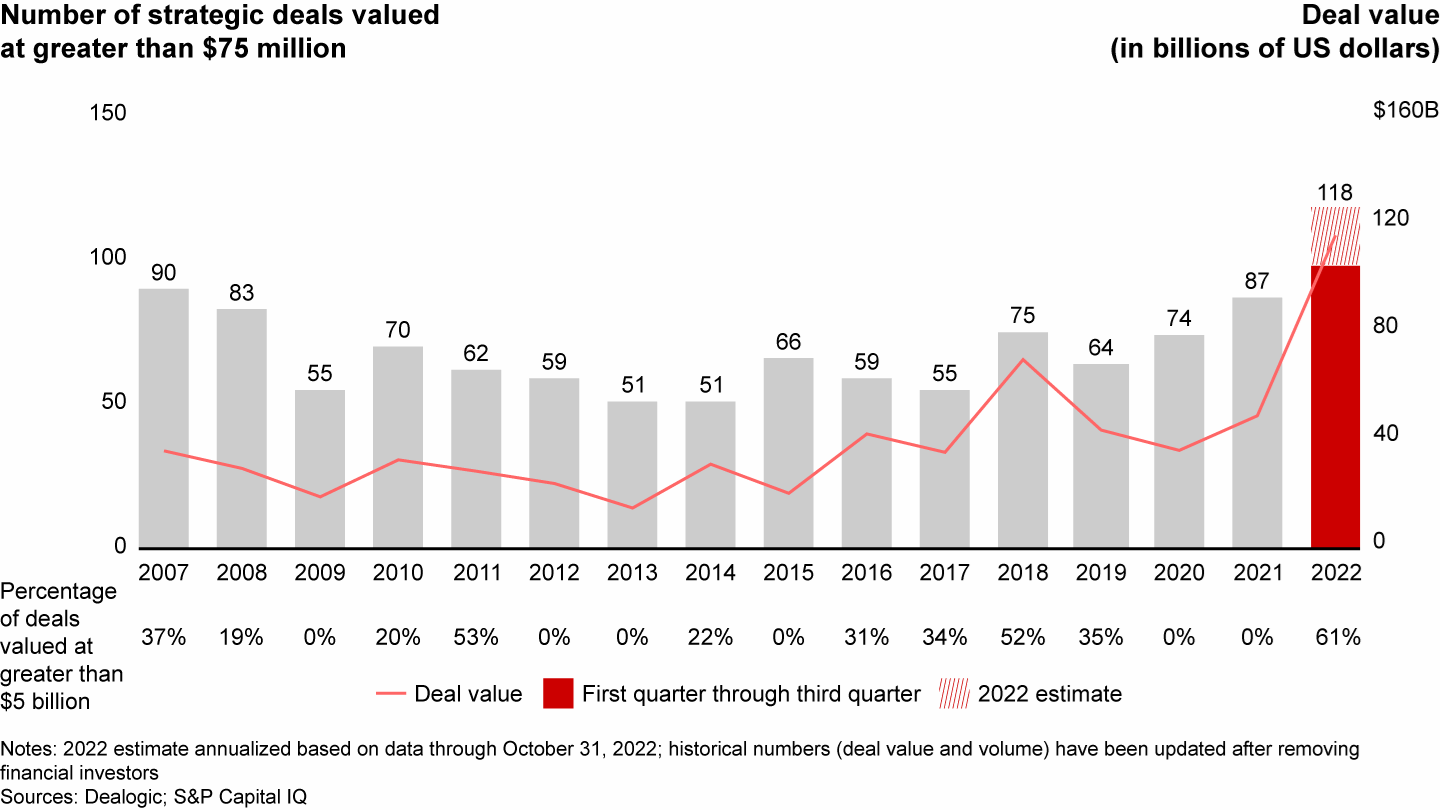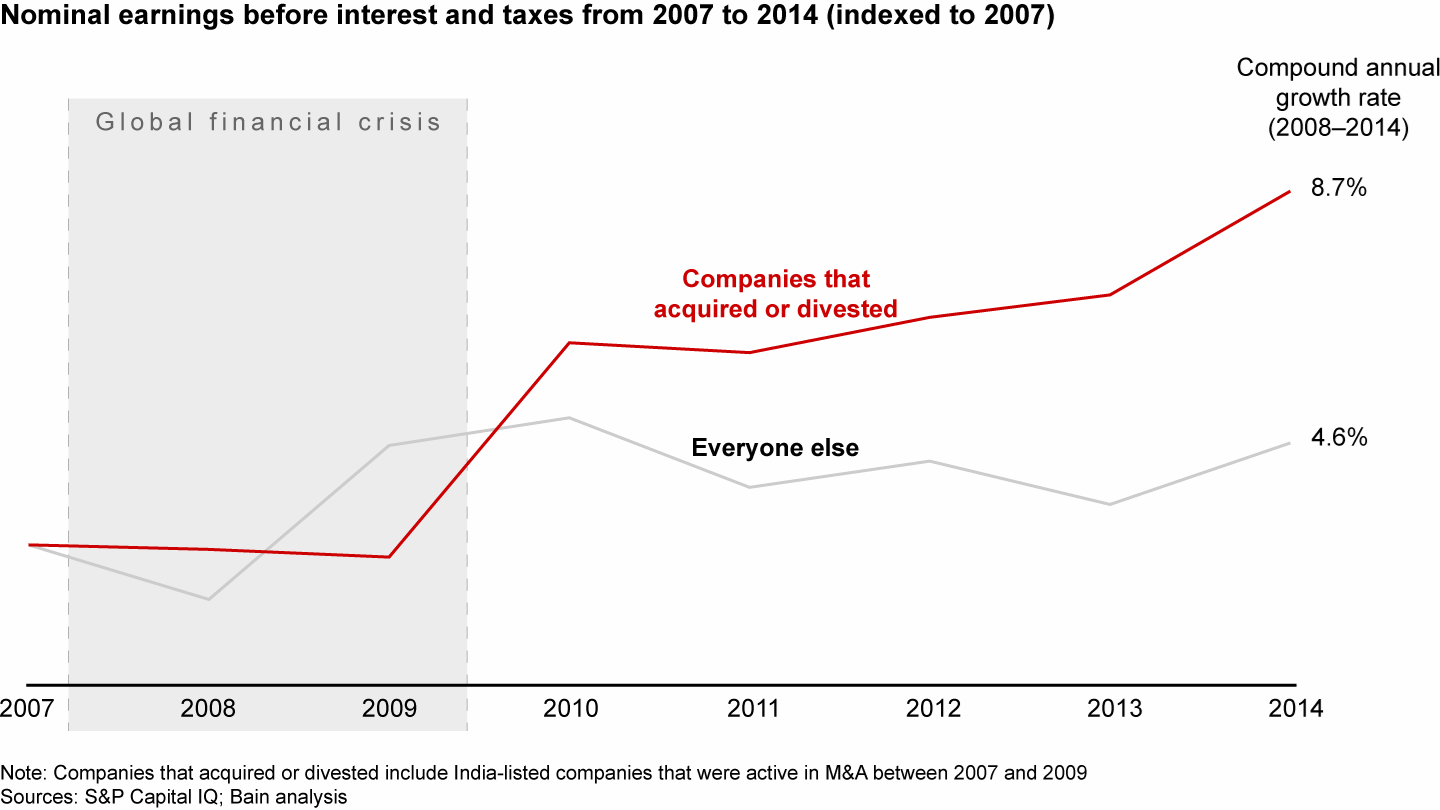M&A Report

At a Glance
- The country’s record levels of cash and availability of assets helped deliver a boom in deal volume, with deal value rising by 139% in 2022.
- Conglomerates are looking for Engine 2 businesses, insurgents for consolidation, and multinationals for diversifying their supply chains.
- Even if India’s economy changes course, executives feel optimistic about the prospects for deals, and they are not pausing M&A.
Este artigo faz parte do Relatório de Fusões e Aquisições de 2023 da Bain.
Strategic M&A deal volume and value reached all-time highs in India in 2022, while dealmaking dropped off in much of the rest of the world.
Several factors have converged to create a robust environment for M&A. Corporate balance sheets are solid, with cash now at record levels. Private equity has ample dry powder to deploy. Foreign direct investment has held steady to the point at which India is a global hotspot as an attractive non-US destination for capital. Sellers are responding to high multiples and bringing more assets (and more quality assets) to the market—and acquirers are ready to move on them. Conglomerates and other traditional businesses are turning to M&A to win future profit pools. In its fourth straight year of steadily growing volume, deal value rose by 139% in 2022 (see Figure 1).
India is bucking the global trend, with strategic M&A deal volume and value at all-time highs


Several key themes emerge from our analysis of deals last year. First, established domestic companies turned to M&A to consolidate. For example, in India’s biggest merger announcement ever, HDFC, the mortgage firm, has signed on to merge with HDFC Bank in a deal valued at $40 billion.
Second, there also were many scope deals. For example, Adani’s $10.5 billion deal for Ambuja Cements and ACC makes it the second-largest cement manufacturer in India. Torrent Pharma bought skin care player Curatio Healthcare to strengthen that part of its portfolio.
What’s behind the scope activity? India’s conglomerates are making bets on new growth engines and future profit pools that offer higher multiples than their traditional businesses. Also, many companies are buying online businesses and combining them with their offline presence to create omnichannel offerings for consumers. Aditya Birla Fashion and Retail bought controlling stakes in Bewakoof, Urbano, and multiple other brands as part of its effort to create a new digital-first house of brands.
Third, the Indian government’s ambitious energy transition policies (e.g., the Ministry of New and Renewable Energy’s National Solar Mission and National Green Hydrogen Mission) open up business opportunities and push conglomerates as well as traditional energy companies to invest in renewables. For instance, in line with the government’s mission, Adani turned to M&A to pursue a goal of becoming the world’s largest integrated hydrogen producer. And the company is acquiring its way to building a presence across the value chain in its ambition to become one of the world’s largest solar/renewables companies, from producing renewables and green energy equipment to creating downstream facilities that produce green hydrogen derivatives such as nitrogenous fertilizers. Multinationals are making similar plays—for example, consider Shell’s purchase of Solenergi Power and the Sprng Energy group of companies.
The Indian government’s ambitious energy transition policies open up business opportunities.
Fourth, India is becoming a prime alternative for global companies that are eager to diversify their supply chains. In a way, India stands to ultimately benefit from recent supply chain disruptions. The shift is fueling deals in areas such as active pharmaceutical ingredients, specialty chemicals, and contract manufacturing, where private equity players are acquiring serial assets and rolling them up to create one large platform. In November, Advent International bought a controlling stake in Avra Laboratories, combining that company with RA Chem Pharma and ZCL Chemicals, two companies it had previously purchased. In another deal, global investment firm PAG led a consortium that bought a controlling stake in the pharmaceutical firm Optimus Group.
And fifth, in a trend we reported on last year, fast-growing insurgents are aggressively buying start-ups. Much of the activity is in consumer tech, edtech, and fintech. For example, eight-year-old Razorpay, which is quickly building a financial ecosystem for businesses around payments and banking, completed its purchase of loyalty and engagements solutions start-up Poshvine in 2022—its seventh acquisition to date.
India-based executives remain optimistic that the M&A train will continue its forward momentum, with 75% of them telling us they expect that there will be more attractive assets available in 2023, according to our M&A Practitioners’ 2023 Outlook Survey. This is higher than the global average of 53%. Meanwhile, 64% of those India executives say that they expect the likelihood of closing an acquisition will increase in 2023, which is more than the global average of 37%. Global companies also appear poised to double down on India as an attractive long-term market.
There is one potential situation that could make dealmakers step back. While India has already hiked interest rates, further aggressive increases could result in M&A activity slowing down. As we’ve seen in the US and other markets, the large increase in interest rates starting in mid-2022 played a big role in M&A activity contracting by 36% globally. This may not be as severe in India, but we should be forewarned about the cause and effect of rising inflation and interest rates.
Even if India’s economy changes course, its executives clearly are positioned to make the bold moves that would help them emerge stronger. That’s what they did last time around. During the 2008–2009 global financial crisis, companies in India that took portfolio actions outgrew their peers two to one in nominal earnings before interest and taxes over the next five years (see Figure 2). Across all economic cycles, companies that engage in frequent and material M&A achieve almost twice the total shareholder growth of nonacquirers, according to Bain’s 20-year assessment of corporate performance.
Downturns are opportunities for bold moves that pay off when markets recover


Yet history tells us that each time has its own unique challenges, and acquirers in India need to pay heed to the special requirements of deals in 2023.
- With the potential for a downturn, companies need to develop a highly tailored integration approach that foremost protects the target’s business but that also lays the appropriate integration playbook for realizing synergies that will bolster the top line—this includes proactive, customer-centered, and data-driven sales playbook integration, product portfolio integration, and go-to-market integration.
- With talent experiencing a moment of profound disruption, companies need to prepare for the reality that merger integration only increases the risk of attrition. And 38% of India-based executives say that they often or always experience challenges with talent retention after deal completion. This is higher than the global average of around 30%. So, executives need to expand people diligence, creatively read the talent landscape, and design integrations with retention in mind. The best companies begin to assess culture and strategic fit before diligence begins. Here, India’s executives can play some catch-up with their counterparts elsewhere. According to our M&A practitioners’ survey, 30% of India-based executives say they begin to assess culture/strategic fit before diligence begins, lower than the global average of 44%.
- Finally, in a time of increasing environmental, social, and corporate governance (ESG) mandates and relentless digital disruption, companies need to combine both ESG and digital capabilities in dealmaking to drive multiple expansion. Both will remain long-term value creation hotspots over the next decade, and the best companies will make them key considerations in their M&A activity.
38% of India-based executives say that they often or always experience challenges with talent retention after deal completion—more than the global average of around 30%.
In the years ahead, companies that build M&A capabilities and use a systematic approach to deals will be those that win in the race to revamp India’s industries and capture an outsized share of the country’s impressive growth.
Este artigo faz parte do Relatório de Fusões e Aquisições de 2023 da Bain.